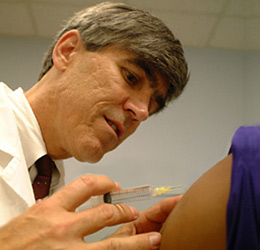 |
 |
 |
 Health & Beauty | July 2006 Health & Beauty | July 2006  
HPV Vaccine Advised for Girls
 HPV Vaccine Advised for Girls HPV Vaccine Advised for Girls


| | A vaccine that could reduce cervical cancer rates by 75 percent is safe and 95 percent effective, according to a study of 1,113 women in North America and Brazil. |
The committee of experts that advises the federal government on immunization policy yesterday recommended that the new vaccine that prevents most cases of cervical cancer be given to all 11- and 12-year-old girls.

The recommendation, which is expected to be accepted by the Department of Health and Human Services and followed by the nation's physicians, marks a first on many fronts.

The human papillomavirus (HPV) vaccine would become the first vaccine against a sexually transmitted disease on the list of immunizations all children should get. It is the first whose main purpose is to prevent cancer. It is the first to target a single sex (although adolescent boys may ultimately be included). It would also become the most expensive of the 16 vaccines on the immunization schedule.

"This is a huge breakthrough for women's health, for prevention, and for cancer prevention, in particular. It's a very exciting day," said Anne Schuchat, a vaccine specialist at the Centers for Disease Control and Prevention.

Early on, some social conservatives questioned whether the vaccine - or its enthusiastic promotion by the government - might indirectly encourage sexual activity by teenagers. But opposition melted.

"The Family Research Council continues to endorse both the distribution and the widespread availability of the vaccine," said Moira Gaul, the coordinator of the organization's Abstinence Project.

She said the council would oppose making the vaccine compulsory. That is because, unlike measles and many childhood infections, HPV is not transmitted casually or through indirect contact in public places such as schools.

The Advisory Committee on Immunization Practices never recommends that an immunization be mandatory for school attendance. That is a decision states make. However, because the "target population" for the new vaccine is already in school, such a requirement is unlikely, several experts said.

At yesterday's meeting in Atlanta, the committee also recommended that the HPV vaccine be included in the federal Vaccines for Children Program, which provides free shots to children on Medicaid, to Alaska-native and Indian children, and to uninsured and some underinsured children. About 40 percent of U.S. children get their vaccines that way.

"That, to me, is the real victory this afternoon," said Kirsten Moore, president of the Reproductive Health Technologies Project, an advocacy group in Washington. "It makes it available to the girls who otherwise couldn't afford it."

HHS acceptance of the committee's recommendation is virtually assured. Most health insurance plans would then add it to their coverage.

Only one company, Merck & Co., makes an HPV vaccine. Its product, called Gardasil, was licensed by the Food and Drug Administration early this month. A second vaccine, made by GlaxoSmithKline PLC, is expected to be approved next year.

HPV is the most common sexually transmitted disease. More than half of people get it within a year of starting sexual activity. It causes no symptoms, and in more than 90 percent of cases, the body clears the virus.

In some women, however, persistent infection causes slow changes to the cervix that can lead to cancer. These can be detected by Pap smear; the test has greatly reduced the disease here in the past 50 years.

There are now about 10,000 new cases of cervical cancer in the United States each year and about 3,700 deaths. It is much more prevalent and fatal in the developing world.

Merck's vaccine, which consists of three shots totaling $360, protects against strains of the virus that cause about 70 percent of cervical cancer cases.

The Vaccines for Children Program only covers people through age 18. In May, Merck announced plans to make the HPV vaccine available to women older than that in households with incomes of up to twice the federal poverty level.

Gardasil is approved for use by girls and women ages 9 through 26. The company estimates there are 118 million people in that age range in the United States, Europe, Japan, Australia and New Zealand. | 
 | |
 |



